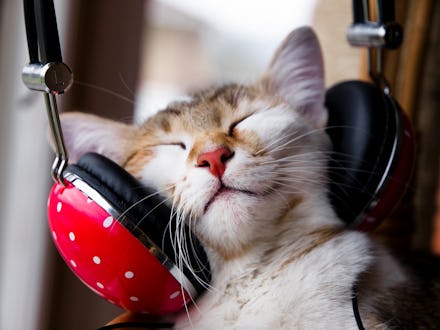Listen to the Music That Scientists Have Developed for Cats

Survivor's "Eye of the Tiger" may be a perfect cat jam, but most cats couldn't care less about music. Until now.
Charles T. Snowdon, a psychologist out of the University of Wisconsin-Madison, has developed a new variety of music that "mimics feline vocal communication and environmental sounds that pique the interest of cats." It's called Music for Cats, and it isn't just some misguided fantasy — this is hard science. In a forthcoming peer-reviewed paper for Applied Animal Behaviour Science, Snowdon demonstrates that cats actually do show "significant preference for and interest" in this cat music when compared to human music. He also believes it could have some surprising therapeutic applications for shelter or feral cats.
Behold: The revolution in feline music-listening is here.
But why? "We were motivated to make music for cats for two reasons," Snowdon told the Huffington Post. "First, many pet owners told us that they play radio music for their pets while they are at work and we wondered if this had any value. Second, we have developed a theory that suggests that species other than humans can enjoy music, but that the music has to be in the frequency range that the species uses to communicate and with tempos that they would normally use."
Snowdon based his research off the idea that all mammals have hardwired templates in their brains to respond emotionally to sound. "If someone were to scream in your presence, your heart rate would increase; there is no way for you to prevent it," the Music for Cats website reads. "You would not, however, respond similarly to the alarm call of a squirrel. Study of the characteristics of a given species gives us a basis for music for that species."
Along with musician David Teie, Snowdon and his team worked to create music based off the sounds and rhythms of cat life.
Cats' meows are often pitched an octave above human vocalizations, so cat music utilizes higher pitches. The tempos match cat behaviors, things like the tempo of purring and of suckling. Contrary to popular belief, purrs are not necessarily a cat's means of indicating comfort and contentment. "What we think cats are doing here is just trying to reassure their person — or [another] cat — who is hearing the purr that they are no threat," John Bradshaw, author of Cat Sense: How the New Feline Science Can Make You a Better Friend to Your Pet, told NPR. "It's a signal to the animals, [and] the people around them to pay attention and try to help them."
The purr, then, is the perfect way to get a cat's attention.
"The rhythms and types of sounds used were clearly well chosen, since the cat's responses do appear to have been largely positive," Bradshaw told Mic by email. According to the Huffington Post, Snowdon found that felines significantly and clearly preferred the cat music — some reportedly even rubbed against the speaker.
It's not exactly headbanging, but we'll take it. Discovery News points out that research on cats indicates that cats rub against something when they're attempting to "claim" that thing or person. Snowdon believes that this music could actually provide a tremendous benefit to shelter cats as a way to calm them and acclimate them to human companionship. He's onto something: Contrary to the popular idea that cats are uncaring loners, cats do actually experience separation anxiety. This music could help cats relax as they freeload their days while their owners are at work.
Bradshaw has his reservations, though. "I can't see how this music would be particularly useful for pet cats ... since they would presumably prefer to interact with their owners," he said. "However, it would be interesting to test the effects of playback in cat shelters, in case it reduced stress in newly-rescued cats."
Yet Music for Cats doesn't plan to stop with cats. Working with the Smithsonian National Zoological Park, researchers are planning to use other species-specific music to provide more enriching environments for animals in captivity. They plan to introduce new music to at least two to three species every year. Teie has already written music for mustached bats and cotton-top tamarins, and his research describing the tamarin's positive responses landed Snowdon and him on the New York Times Year in Ideas list of 2009.
The Music for Cats CD will be coming soon. Until then, you can listen to three sample tracks on the company's website.